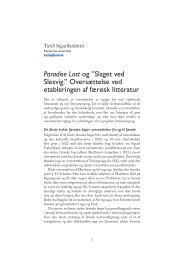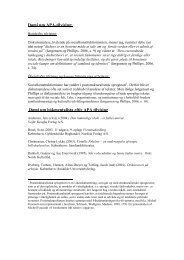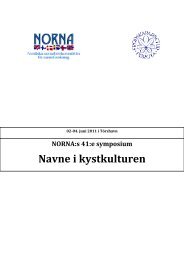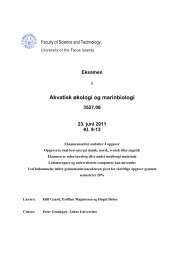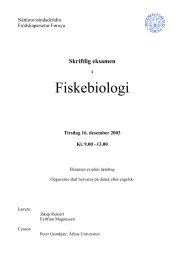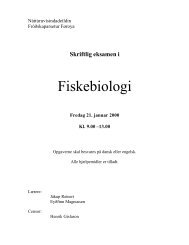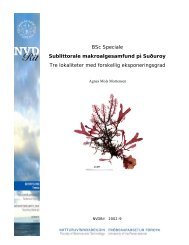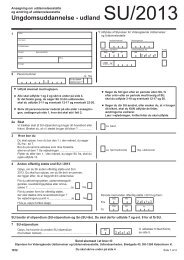Infectious Pancreatic Necrosis Virus (IPNV) - Fróðskaparsetur Føroya
Infectious Pancreatic Necrosis Virus (IPNV) - Fróðskaparsetur Føroya
Infectious Pancreatic Necrosis Virus (IPNV) - Fróðskaparsetur Føroya
You also want an ePaper? Increase the reach of your titles
YUMPU automatically turns print PDFs into web optimized ePapers that Google loves.
1 Introduction<br />
1.1 Background<br />
Listeria monocytogenes was first described by Murray et al. (1926) in 1924. The organism<br />
was isolated from rabbits and guinea pigs.<br />
L. monocytogenes is a Gram-positive bacterium that occurs widely in both agricultural (soil,<br />
vegetation, silage, faecal material, sewage, and water), aquacultural, and food processing<br />
environments (Fenlon 1999). L. monocytogenes is a transitory resident of the intestinal tract in<br />
humans, with 2 to 10% of the general population being carriers of the microorganism without<br />
any apparent health consequences (Farber & Peterkin 1991 and CAC 2007).<br />
L. monocytogenes is an opportunistic pathogen which can cause the bacterial infection<br />
listeriosis. The disease primarily manifests as sepsis, meningitis or materno-fetal infections<br />
(Anonymous 2010). The likelihood that L. monocytogenes can establish a systemic * infection<br />
is dependent on a number of factors, including the number of microorganisms consumed, host<br />
susceptibility, and virulence of the specific isolate ingested. All strains of L. monocytogenes<br />
appear to be pathogenic (FAO/WHO 2004). Listeriosis is most prevalent in people in certain<br />
risk groups, which include the elderly, newborns, pregnant women and immunocompromised<br />
people (Lundén 2004).<br />
Listeriosis is mainly observed in industrialized countries. It is not known whether these<br />
differences in incidence rates between developed and less developed countries reflect<br />
geographical differences, differences in food habits and food storage, or differences in<br />
diagnosis and reporting practices (FAO/WHO 2004). The total incidence of invasive<br />
listeriosis is estimated to be 2-10 per million population per annum in the countries where<br />
data are available (FAO 1999). Because of the high mortality rate some countries have<br />
introduced a zero-tolerance policy in ready-to-eat products.<br />
Due to the remote location of the Faroe Islands, the Faroese people have for centuries had to<br />
rely on the ocean for food and their livelihoods. Even today, fish represents more than 96% of<br />
the total export. Farmed salmon represents around one third of all export from the Faroe<br />
Islands. No matter where you go on the Faroe Islands, the Atlantic Ocean is always close at<br />
* An infection in which the pathogen is distributed throughout the body rather than concentrated in one area. L.<br />
monocytogenes multiplies intracellularly within the macrophages.<br />
4



